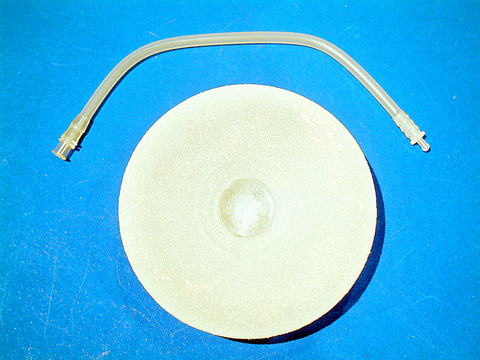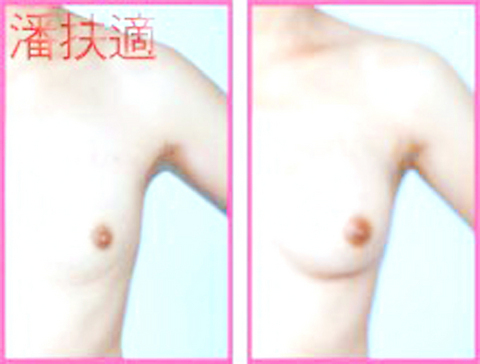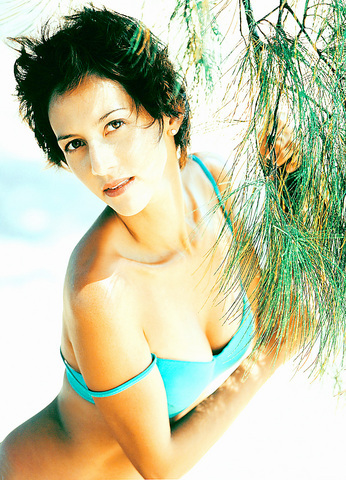From those who use padded bras to those who use herbal concoctions, women around the world are obsessed with breast size. Yet those who undergo breast augmentation surgery are often viewed as exhibitionists.
In Taiwan, most breast augmentation is performed on women between 40 and 50, yet implants could be making a comeback in the younger generation.

PHOTO COURTESY OF MUTABOR CLINIC
"The majority of my clients are women past their childbearing years. Breasts tend to get smaller after a woman has children, and some women become unhappy with the way their bodies look with age," said Dr Pan Fu-shih (潘扶適), a plastic surgeon certified by the American Board of Plastic Surgery.

PHOTO COURTESY OF SPORTS VANITY
Of roughly 300 certified plastic surgeons in Taiwan, more than half practice cosmetic surgery, a major rise from the 15 doctors practicing when Pan returned from the US 10 years ago. No surgeon in Taiwan specializes in breast augmentation, so clients tend to be referrals from previous patients.
According to a major saline implant distributor, demand for their products has risen every year for the past three years at a rate of 5 to 10 percent. Pan himself performs two operations a week in Taipei, only a slight increase from previous years, he said.

PHOTO COURTESY OF SPORTS VANITY
This small boost in implant jobs does not explain the large amount of cleavage revealed in popular fashion magazines and newspapers, which according to those in the fashion industry is a trend of the last five years.
"Showing cleavage is acceptable and almost necessary," explained Lorie Lee (李珊珊), creative director of the local fashion magazine Sports Vanity.
A swimsuit model, Lee knows the importance of "busty shots," but as an insider she also knows a few tips for faking it.
"Of course the public loves big breasts. But breast jobs are not as popular in Taiwan as they are in the US. There are other ways to create cleavage, such as silicone bras and special tape to create different effects," she said.
Padded bras don't work for everyone, or at least they can't achieve the "perfect results," that Miss Chou, a breast implant recipient, claimed to have gotten.
Giving only her surname, Chou, 27, had the surgery done three years ago, after two of her friends had it done.
"They recommended me to Dr. Pan and judging by how good they looked, I wanted to do it." A size A before the operation, Chou's cup size is not the only thing that received a boost. "I feel more confident. My clothes fit and look better. More people notice me."
Nothing new
Breast implants are not new to Taiwan. In fact, they experienced relative popularity from the early 1980s until 1992, when it was reported that silicone implants were responsible for connective tissue diseases in some women. The so-called breast implant crisis began with a ban on silicone implants in the US and subsequently Taiwan.
Despite their wide use in Europe, they are still unavailable in North America and Taiwan. In their place a safer yet less realistic saline implant is used.
"We are starting to see a slight but steady increase in women seeking breast augmentation again," said Pan, but whether it will become popular among young women is yet to be seen.
Rachel Ho (何瑞琴), a client consultant at the Mutador cosmetic surgery clinic in Taipei, said while middle-aged women account for most operations at the clinic, more women are beginning to have the operation.
"The reasons for getting the surgery vary depending on a client's age. It used to be a woman wanted to impress her husband. Maybe her breasts got smaller after giving birth, or maybe her husband was having an affair. The younger clients [in their early 20s] are more concerned with body image," Ho said.
The surgery takes anywhere from one to two hours, but the recovery period lasts several months. Stitches are removed after a week, and swelling and bruising eases in two weeks, but the final shape does not surface until at least three months after surgery. A new set of breasts costs from NT$150,000 to NT$200,000.
As with any operation there are potential complications. Short-term problems include prolonged swelling and blood clots. Long-term complications can result if a body rejects the implants. But such occurrences are rare, said Pan, who claims a 100-percent success rate so far.
"The number-one problem with plastic surgery is unrealistic expectations. No amount of surgery will make a body or life perfect," he said.
There have been a number of "horror stories" from operations performed by non-certified and unqualified doctors. Pan also performs corrective surgeries on patients unsatisfied with the results of earlier breast jobs.
Alternatives
Less costly and less risky options are on the rise. There is a wide selection of massagers, pumps and pills available on the Internet and at the back of some women's magazines.
Alternatively, women in Taiwan have the advantage of traditional medicine, which claims to help firm breast tissue and enhance size.
James Tseng (
Tseng knew the recipe for a relevant concoction off the top of his head. It included six ingredients, one of which is papaya (perhaps the basis of the myth that papaya milkshakes increases bust size). Acupuncture and self-massage techniques are also prescribed, and acupuncture is becoming the most popular, he said.
For Tseng and many women, traditional medicine is a safer alternative to implants. "Plastic surgery is the least natural thing you can do to your body," he said.
But not everyone cares. "If I can make myself look better, then why not?" asked Maggie Hsu when talking about her decision to get implants this year. "I tried massage and herbal pills, but it didn't work. This is something I've wanted for a long time but never had the money for. Now I do."
And there was no pressure from her boyfriend, who she said dislikes the idea. "He doesn't understand why I want to spend money on something that is fake. But it's my body." And ultimately it's going to be her decision.

The canonical shot of an East Asian city is a night skyline studded with towering apartment and office buildings, bright with neon and plastic signage, a landscape of energy and modernity. Another classic image is the same city seen from above, in which identical apartment towers march across the city, spilling out over nearby geography, like stylized soldiers colonizing new territory in a board game. Densely populated dynamic conurbations of money, technological innovation and convenience, it is hard to see the cities of East Asia as what they truly are: necropolises. Why is this? The East Asian development model, with

June 16 to June 22 The following flyer appeared on the streets of Hsinchu on June 12, 1895: “Taipei has already fallen to the Japanese barbarians, who have brought great misery to our land and people. We heard that the Japanese occupiers will tax our gardens, our houses, our bodies, and even our chickens, dogs, cows and pigs. They wear their hair wild, carve their teeth, tattoo their foreheads, wear strange clothes and speak a strange language. How can we be ruled by such people?” Posted by civilian militia leader Wu Tang-hsing (吳湯興), it was a call to arms to retake

This is a deeply unsettling period in Taiwan. Uncertainties are everywhere while everyone waits for a small army of other shoes to drop on nearly every front. During challenging times, interesting political changes can happen, yet all three major political parties are beset with scandals, strife and self-inflicted wounds. As the ruling party, the Democratic Progressive Party (DPP) is held accountable for not only the challenges to the party, but also the nation. Taiwan is geopolitically and economically under threat. Domestically, the administration is under siege by the opposition-controlled legislature and growing discontent with what opponents characterize as arrogant, autocratic

When Lisa, 20, laces into her ultra-high heels for her shift at a strip club in Ukraine’s Kharkiv, she knows that aside from dancing, she will have to comfort traumatized soldiers. Since Russia’s 2022 invasion, exhausted troops are the main clientele of the Flash Dancers club in the center of the northeastern city, just 20 kilometers from Russian forces. For some customers, it provides an “escape” from the war, said Valerya Zavatska — a 25-year-old law graduate who runs the club with her mother, an ex-dancer. But many are not there just for the show. They “want to talk about what hurts,” she